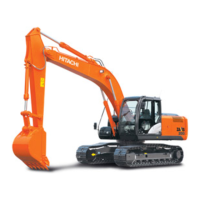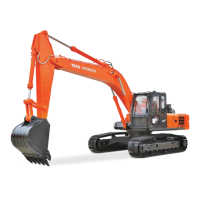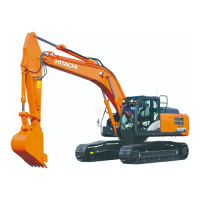Do you have a question about the Hitachi ZAXIS 200 Series and is the answer not in the manual?
Manual is for experienced technicians, providing technical info for maintenance and repair.
Lists other relevant materials like Operator's Manual, Parts Catalog, and Engine manuals.
Describes the three volumes of the Service Manual: Operational Principle, Troubleshooting, and Workshop.
Explains the format of page numbers, including group and section numbers for reference.
Defines safety alert symbols and signal words (DANGER, WARNING, CAUTION, IMPORTANT, NOTE) and their meanings.
Provides a table for converting SI units to MKSA and English units used in the manual.
Classifies Hitachi machine models into four categories with corresponding model numbers for reference.
Explains the safety alert symbol and the importance of following precautions to prevent personal injury.
Defines and explains the meaning of signal words like DANGER, WARNING, CAUTION, IMPORTANT, and NOTE.
Emphasizes reading and adhering to all safety signs and messages for safe operation and maintenance.
Advises preparedness for emergencies by keeping first aid kits, fire extinguishers, and emergency contact numbers accessible.
Lists essential personal protective equipment (PPE) such as hard hats, safety shoes, gloves, and eyewear for safe operation.
Warns about hearing damage from prolonged exposure to loud noise and recommends using hearing protection.
Stresses the importance of daily walk-around inspections before starting the machine to prevent personal injury.
Provides safety guidelines for the operator's cab, focusing on cleanliness and avoiding flammable items.
Details safe practices for mounting and dismounting the machine using designated handholds and steps.
Explains proper seat adjustment for operator comfort, control access, and preventing fatigue-related misoperations.
Highlights the critical necessity of wearing seat belts to prevent injury or ejection during machine overturns.
Covers safe machine operation, including awareness of bystanders, functioning travel alarms, and signal persons.
Warns against starting the engine from outside the operator's seat to prevent runaway machine incidents.
Provides crucial safety advice for jump starting, warning of explosion risks and detailing correct procedures.
Advises against allowing extra riders on the machine to ensure operator visibility and prevent injury.
Recommends clear signaling and using a signal person for jobs involving multiple machines on site.
Explains how to correctly identify the machine's driving direction relative to the operator's position.
Provides guidelines for safe driving, including checking travel controls, avoiding obstructions, and operating on slopes.
Details precautions to prevent rollaways, such as parking on level ground and securing the machine properly.
Warns about hazards of backing up or swinging, stressing awareness of bystanders and signal persons.
Lists precautions to avoid machine tipping, particularly on slopes, including bucket position and speed control.
Emphasizes maintaining a safe distance from electric lines to prevent electrocution hazards.
Covers safe practices for lifting and handling objects, including load security and personnel safety.
Advises wearing protective eyewear and keeping bystanders away from areas with potential flying debris.
Outlines steps for safely parking the machine, including lowering attachments, shutting off the engine, and securing the cab.
Provides safety instructions for handling flammable fluids to prevent fires and explosions.
Details precautions for loading, unloading, and transporting the machine, focusing on stability and safe ramp use.
Lists essential safety steps before performing maintenance, like parking on level ground and relieving hydraulic pressure.
Instructs to use 'Do Not Operate' tags and warn others before commencing service work on the machine.
Advises on securely supporting the machine or attachments when working on lifted components to prevent collapse.
Warns about entanglement risks with moving machine parts and recommends keeping body parts and clothing away.
Advises caution with pressurized components like track adjusters to prevent injury from flying parts.
Emphasizes securely storing attachments to prevent them from falling and causing injury.
Stresses using appropriate tools and recommended parts to avoid safety hazards and injuries.
Warns about hot fluids and surfaces, advising safe handling and procedures for hot components.
Highlights the importance of periodic hose replacement due to aging and fatigue to prevent failures.
Details severe risks of high-pressure fluid injection and advises on safe disconnection and leak detection.
Covers fire prevention by checking for leaks, electrical shorts, and cleaning flammable materials.
Manual is for experienced technicians, providing technical info for maintenance and repair.
Lists other relevant materials like Operator's Manual, Parts Catalog, and Engine manuals.
Describes the three volumes of the Service Manual: Operational Principle, Troubleshooting, and Workshop.
Explains the format of page numbers, including group and section numbers for reference.
Defines safety alert symbols and signal words (DANGER, WARNING, CAUTION, IMPORTANT, NOTE) and their meanings.
Provides a table for converting SI units to MKSA and English units used in the manual.
Classifies Hitachi machine models into four categories with corresponding model numbers for reference.
Explains the safety alert symbol and the importance of following precautions to prevent personal injury.
Defines and explains the meaning of signal words like DANGER, WARNING, CAUTION, IMPORTANT, and NOTE.
Emphasizes reading and adhering to all safety signs and messages for safe operation and maintenance.
Advises preparedness for emergencies by keeping first aid kits, fire extinguishers, and emergency contact numbers accessible.
Lists essential personal protective equipment (PPE) such as hard hats, safety shoes, gloves, and eyewear for safe operation.
Warns about hearing damage from prolonged exposure to loud noise and recommends using hearing protection.
Stresses the importance of daily walk-around inspections before starting the machine to prevent personal injury.
Provides safety guidelines for the operator's cab, focusing on cleanliness and avoiding flammable items.
Details safe practices for mounting and dismounting the machine using designated handholds and steps.
Explains proper seat adjustment for operator comfort, control access, and preventing fatigue-related misoperations.
Highlights the critical necessity of wearing seat belts to prevent injury or ejection during machine overturns.
Covers safe machine operation, including awareness of bystanders, functioning travel alarms, and signal persons.
Warns against starting the engine from outside the operator's seat to prevent runaway machine incidents.
Provides crucial safety advice for jump starting, warning of explosion risks and detailing correct procedures.
Advises against allowing extra riders on the machine to ensure operator visibility and prevent injury.
Recommends clear signaling and using a signal person for jobs involving multiple machines on site.
Explains how to correctly identify the machine's driving direction relative to the operator's position.
Provides guidelines for safe driving, including checking travel controls, avoiding obstructions, and operating on slopes.
Details precautions to prevent rollaways, such as parking on level ground and securing the machine properly.
Warns about hazards of backing up or swinging, stressing awareness of bystanders and signal persons.
Lists precautions to avoid machine tipping, particularly on slopes, including bucket position and speed control.
Emphasizes maintaining a safe distance from electric lines to prevent electrocution hazards.
Covers safe practices for lifting and handling objects, including load security and personnel safety.
Advises wearing protective eyewear and keeping bystanders away from areas with potential flying debris.
Outlines steps for safely parking the machine, including lowering attachments, shutting off the engine, and securing the cab.
Provides safety instructions for handling flammable fluids to prevent fires and explosions.
Details precautions for loading, unloading, and transporting the machine, focusing on stability and safe ramp use.
Lists essential safety steps before performing maintenance, like parking on level ground and relieving hydraulic pressure.
Instructs to use 'Do Not Operate' tags and warn others before commencing service work on the machine.
Advises on securely supporting the machine or attachments when working on lifted components to prevent collapse.
Warns about entanglement risks with moving machine parts and recommends keeping body parts and clothing away.
Advises caution with pressurized components like track adjusters to prevent injury from flying parts.
Emphasizes securely storing attachments to prevent them from falling and causing injury.
Stresses using appropriate tools and recommended parts to avoid safety hazards and injuries.
Warns about hot fluids and surfaces, advising safe handling and procedures for hot components.
Highlights the importance of periodic hose replacement due to aging and fatigue to prevent failures.
Details severe risks of high-pressure fluid injection and advises on safe disconnection and leak detection.
Covers fire prevention by checking for leaks, electrical shorts, and cleaning flammable materials.
| Brand | Hitachi |
|---|---|
| Model | ZAXIS 200 Series |
| Category | Excavators |
| Language | English |












